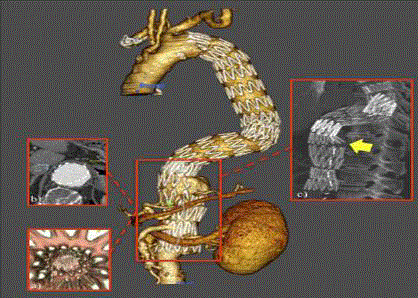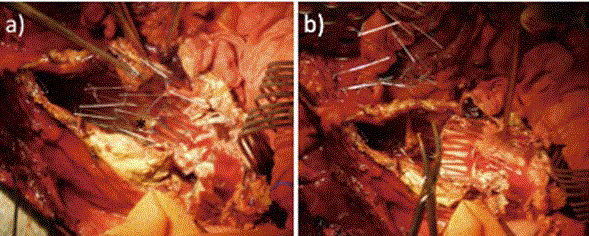Case Report
Long Term Complication after Petticoat Technique in Type B Aortic Dissection
Giovanni Spinella*, Valerio Gazzola, Domenico Palombo, Simone Mambrini and Bianca Pane
Vascular and Endovascular Surgery Unit, Ospedale Policlinico San Martino, University of Genoa, Genoa, Italy
*Corresponding author: Giovanni Spinella, Vascular and Endovascular Surgery Unit, Ospedale Policlinico San Martino, University of Genoa, Genoa, Largo Rosanna Benzi, 10–16132 Genoa, Italy
Published: 01 Nov, 2018
Cite this article as: Spinella G, Gazzola V, Palombo
D, Mambrini S, Pane B. Long Term
Complication after Petticoat Technique
in Type B Aortic Dissection. Clin Surg.
2018; 3: 2184.
Abstract
We reported a case of complicated Type B aortic dissection treated by TEVAR and PETTICOAT
technique. Angio-CT scan follow-up showed a complete false lumen thrombosis in most of the
treated aorta with a residual short portion of dissected aorta at the renal level, however, the aortic
diameter continued to expand. At 10 years follow-up the maximum aortic diameter was 76 mm.
After open repair the patients died due to respiratory failure. This case shows how long-term
PETTICOAT technique results may not protect patients from the aneurysm evolution of the aorta.
Keywords: Type B aortic dissection; Tevar; Petticoat technique
Introduction
The aim of endovascular treatment in Type B aortic dissections is to close the proximal entry
tear and depressurizing the false lumen in order to improve aortic remodeling.
We find several endovascular techniques that can be taken into consideration to achieve false
lumen thrombosis in case of reinterventions in chronic Type B aortic dissection [1].
Indeed in order to promote aortic remodeling in the acute Type B aortic dissection and to avoid
follow-up reinterventions, some authors suggested the use of the provisional extension to induce
complete attachment (PETTICOAT) technique. Unfortunately, this technique failed to demonstrate
a reduction of aortic diameters at 2 years of follow-up [2].
The fate of patients in whom the uncovered stent (PETTICOAT Technique) was used is
unknown.
We can report a clinical case with 10 years follow-up of PETTICOAT Technique.
Case Presentation
A 78-year-old male patient who underwent 10 years earlier a TEVAR + PETTICOAT technique
for complicated Type B aortic dissection. Throughout the follow-up we observed a progressive
increase in aortic diameters shown by annual CT scan. At 10 years follow-up the maximum
aortic diameter had reached 76 mm, and we also observed a fracture of the uncovered stent ring
(Figure 1). In relation to the comorbidities and the presence of the
PETTICOAT stent, an open repair was chosen. Through a thoracobrake
laparotomy at the VII intercostal space, the thoraco-abdominal
aorta was surgically exposed. A femoral-femoral extracorporeal
circulation was used, initially with a distal aortic warm reperfusion
and, when the aneurysm was opened, a selective visceral and renal
vessels perfusion was achieved. After proximal and distal aortic
clamping, the aneurysm sac was opened only in its initial portion,
and then a terminal-end anastomosis was performed with a straight
Dacron prosthesis (30 mm diameter). At this point the aneurysm sac
was completely opened, the stent was removed (Figure 2) and the
straight prosthesis was anastomosed in suprarenal aorta (inclusion of
visceral and renal vessels).
The post-operative course was characterized by a worsening of
respiratory function and the patient died on the 15th postoperative
day due to respiratory failure.
Figure 1
Figure 1
CT scan 10 years follow-up.
a) Caudo-cranial virtual navigator.
b) Maximum aortic diameter.
c) Maximum Intensity Projection (MIP) showed the fracture of uncovered stents.
Figure 2
Discussion
We reported a case of complicated Type B aortic dissection
treated by TEVAR and PETTICOAT technique.
Angio-CT scan follow-up showed a complete false lumen
thrombosis in most of the treated aorta with a short segment of
dissected aorta at the renal level; despite this early good result, during
the follow-up the aortic diameter continued to expand.
This aspect should represent a point of reflection regarding the use
of PETTICOAT Technique: It wouldn’t seem to protect the dissected
aorta by aneurysmal dilatation during the follow-up. For this reason,
some authors proposed the use of a bare stent associated with the
ballooning of dissected aorta in order to facilitate the attachment of
the dissected lamella to the remaining part of the aortic wall [3].
Recently Melissano et al. showed a preliminary experience in this
procedure achieving an excellent aortic remodeling; however these
patients had a short follow-up with a mean time of only 7.2 months.
The authors observed no complications and the complete exclusion
of the false lumen in all cases [4].
Even in our experience the false lumen was occluded and the stent
was completely expanded without aortic ballooning. Unfortunately,
during the follow-up, we observed a stent rupture associated with an
aneurysmal evolution of treated aorta.
In patients with Type B aortic dissection who underwent
endovascular treatment the key point is the long-term results.
Unfortunately, despite the efficacy of the endovascular treatment,
the aortic wall remains pathologic and can result in an aneurysmal
evolution during long term follow-up.
In conclusion, the evolution of aortic remodeling in type B
dissection remains an open issue. The new devices and endovascular
technique can help to improve the aortic remodeling particularly in
the long term follow-up.
References
- Boufi M, Patterson BO, Grima MJ, Karthikesalingam A, Hudda MT, Holt PJ, et al. Systematic review of reintervention after thoracic endovascular repair for chronic type B dissection. Ann Thorac Surg. 2017;103(6):1992-2004.
- Lombardi JV, Cambria RP, Nienaber CA, Chiesa R, Mossop P, Haulon S, et al. Aortic remodeling after endovascular treatment of complicated type B aortic dissection with the use of a composite device design. J Vasc Surg. 2014;59(6):1544-54.
- Hofferberth SC, Boston RC, McLachlan CS, Mossop PJ. Stent-assisted balloon-induced intimal disruption and relamination in aortic dissection repair: the STABILISE concept. J Thorac Cardiovasc Surg. 2014;147(4):1240-5.
- Melissano G, Bertoglio L, Rinaldi E, Mascia D, Kahlberg A, Loschi D, et al. Satisfactory short-term outcomes of the STABILISE technique for type B aortic dissection. J Vasc Surg. 2018;68(4):966-75.


